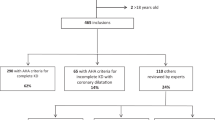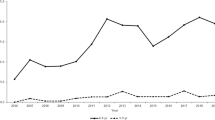Abstract
Kawasaki disease (KD) is the most common cause of acquired heart disease in children. Intravenous immunoglobulin (IVIG) is the standard therapy for KD, but more than 10% of KD patients do not respond to IVIG and are at high risk for the development of coronary artery lesions (CALs). To identify clinical and genetic risk factors associated with CAL development and IVIG nonresponsiveness, this study analyzed the clinical data for 478 Korean KD patients. Multivariate logistic regression analysis showed that incomplete KD, IVIG nonresponse, fever duration of 7 days or longer, and the CC/AC genotypes of the rs7604693 single nucleotide polymorphism (SNP) in the PELI1 gene were significantly associated with the development of CALs, with odds ratios (ORs) ranging from 2.06 to 3.04. The risk of CAL formation was synergistically increased by the addition of individual risk factors, particularly the genetic variant in the PELI1 gene. Multivariate analysis also showed that a serum albumin level of 3.6 g/dl or lower was significantly associated with nonresponsiveness to IVIG [OR, 2.76; 95% confidence interval (CI), 1.34–5.68; P = 0.006]. Conclusively, incomplete KD, IVIG nonresponsiveness, long febrile days, and the rs7604693 genetic variant in the PELI1 gene are major risk factors for the development of CALs, whereas low serum albumin concentration is an independent risk factor for IVIG nonresponsiveness.




Similar content being viewed by others
References
Ashouri N, Takahashi M, Dorey F, Mason W (2008) Risk factors for nonresponse to therapy in Kawasaki disease. J Pediatr 153:365–368
Beiser AS, Takahashi M, Baker AL, Sundel RP, Newburger JW (1998) A predictive instrument for coronary artery aneurysms in Kawasaki disease. Am J Cardiol 81:1116–1120
Burgner D, Davila S, Breunis WB, Ng SB, Li Y, Bonnard C, Ling L, Wright VJ, Thalamuthu A, Odam M, Shimizu C, Burns JC, Levin M, Kuijpers TW, Hibberd ML, International Kawasaki Disease Genetics Consortium (2009) A genome-wide association study identifies novel and functionally related susceptibility loci for Kawasaki disease. PLoS Genet 5:e1000319
Burns JC, Glodé MP (2004) Kawasaki syndrome. Lancet 364:533–554
Burns JC, Shike H, Gordon JB, Malhotra A, Schoenwetter M, Kawasaki T (1996) Sequelae of Kawasaki disease in adolescents and young adults. J Am Coll Cardiol 28:253–257
Burns JC, Capparelli EV, Brown JA, Newburger JW, Glode MP (1998) Intravenous gamma-globulin treatment and retreatment in Kawasaki disease. US/Canadian Kawasaki Syndrome Study Group. Pediatr Infect Dis J 17:1144–1148
Dajani AS, Taubert KA, Takahashi M, Bierman FZ, Freed MD, Ferrieri P, Gerber M, Shulman ST, Karchmer AW, Wilson W, Peter G, Durack DT, Rahimtool SH (1994) Guidelines for long-term management of patients with Kawasaki disease: report from the Committee on Rheumatic Fever, Endocarditis, and Kawasaki Disease, Council on Cardiovascular Disease in the Young, American Heart Association. Circulation 89:916–922
de Zorzi A, Colan SD, Gauvreau K, Baker AL, Sundel RP, Newburger JW (1998) Coronary artery dimensions may be misclassified as normal in Kawasaki disease. J Pediatr 133:254–258
Durongpisitkul K, Gururaj VJ, Park JM, Martin CF (1995) The prevention of coronary artery aneurysm in Kawasaki disease: a meta-analysis on the efficacy of aspirin and immunoglobulin treatment. Pediatrics 96:1057–1061
Durongpisitkul K, Soongswang J, Laohaprasitiporn D, Nana A, Prachuabmoh C, Kangkagate C (2003) Immunoglobulin failure and retreatment in Kawasaki disease. Pediatr Cardiol 24:145–148
Furusho K, Kamiya T, Nakano H, Kiyosawa N, Shinomiya K, Hayashidera T, Hirose O, Yokoyama T, Baba K, Mori C (1984) High-dose intravenous gammaglobulin for Kawasaki disease. Lancet 2:1055–1058
Harada K (1991) Intravenous gamma globulin treatment in Kawasaki disease. Acta Paediatr Jpn 33:805–810
Honkanen VE, McCrindle BW, Laxer RM, Feldman BM, Schneider R, Silverman ED (2003) Clinical relevance of the risk factors for coronary artery inflammation in Kawasaki disease. Pediatr Cardiol 24:122–126
Kato H, Inoue O, Kawasaki T, Fujiwara H, Watanabe T, Toshima H (1992) Adult coronary artery disease probably due to childhood Kawasaki disease. Lancet 340:1127–1129
Kato H, Sugimura T, Akagi T, Sato N, Hashino K, Maeno Y, Kazue T, Eto G, Yamakawa R (1996) Long-term consequences of Kawasaki disease. A 10- to 21-year follow-up study of 594 patients. Circulation 94:1379–1385
Kim JJ, Hong YM, Sohn S, Jang GY, Ha KS, Yun SW, Han MK, Lee KY, Song MS, Lee HD, Kim DS, Lee JE, Shin ES, Jang JH, Lee YS, Kim SY, Lee JY, Han BG, Wu JY, Kim KJ, Park YM, Seo EJ, Park IS, Lee JK, Korean Kawasaki Disease Genetics Consortium (2011) A genome-wide association analysis reveals 1p31 and 2p13.3 as susceptibility loci for Kawasaki disease. Hum Genet 129:487–495
Koren G, Lavi S, Rose V, Rowe R (1986) Kawasaki disease: review of risk factors for coronary aneurysms. J Pediatr 108:388–392
Kuo HC, Liang CD, Wang CL, Yu HR, Hwang KP, Yang KD (2010) Serum albumin level predicts initial intravenous immunoglobulin treatment failure in Kawasaki disease. Acta Paediatr 99:1578–1583
Lehman TJ, Mahnovski V (1988) Animal models of vasculitis. Lessons we can learn to improve our understanding of Kawasaki disease. Rheum Dis Clin N Am 14:479–487
Mori M, Imagawa T, Yasui K, Kanaya A, Yokota S (2000) Predictors of coronary artery lesions after intravenous gamma globulin treatment in Kawasaki disease. J Pediatr 137:177–180
Morikawa Y, Ohashi Y, Harada K, Asai T, Okawa S, Nagashima M, Katoh T, Baba K, Furusho K, Okuni M, Osano M (2000) Coronary risks after high-dose gamma globulin in children with Kawasaki disease. Pediatr Int 42:464–469
Moynagh PN (2009) The Pellino family: IRAK E3 ligases with emerging roles in innate immune signalling. Trends Immunol 30:33–42
Newburger JW, Takahashi M, Gerber MA, Gewitz MH, Tani LY, Burns JC, Shulman ST, Bolger AF, Ferrieri P, Baltimore RS, Wilson WR, Baddour LM, Levison ME, Pallasch TJ, Falace DA, Taubert KA; Committee on Rheumatic Fever, Endocarditis and Kawasaki Disease, Council on Cardiovascular Disease in the Young, American Heart Association, American Academy of Pediatrics (2004) Diagnosis, treatment, and long-term management of Kawasaki disease: a statement for health professionals from the Committee on Rheumatic Fever, Endocarditis, and Kawasaki Disease, Council on Cardiovascular Disease in the Young, American Heart Association. Circulation 110:2747–2771
Newburger JW, Takahashi M, Burns JC, Beiser AS, Chung KJ, Duffy CE, Glode MP, Mason WH, Reddy V, Sanders SP, Shulman ST, Wiggins JW, Hicks RV, Fulton DR, Lewis AB, Leung DYM, Colton T, Rosen FS, Melish ME (1986) The treatment of Kawasaki syndrome with intravenous gamma globulin. N Engl J Med 315:341–347
Rosenkranz ME, Schulte DJ, Agle LM, Wong MH, Zhang W, Ivashkiv L, Doherty TM, Fishbein MC, Lehman TJ, Michelsen KS, Arditi M (2005) TLR2 and MyD88 contribute to Lactobacillus casei extract-induced focal coronary arteritis in a mouse model of Kawasaki disease. Circulation 112:2966–2973
Sonobe T, Kiyosawa N, Tsuchiya K, Aso S, Imada Y, Imai Y, Yashiro M, Nakamura Y, Yanagawa H (2007) Prevalence of coronary artery abnormality in incomplete Kawasaki disease. Pediatr Int 49:421–426
Takeda K, Akira S (2004) TLR signaling pathways. Semin Immunol 16:3–9
Terai M, Shulman ST (1997) Prevalence of coronary artery abnormalities in Kawasaki disease is highly dependent on gamma globulin dose but independent of salicylate dose. J Pediatr 131:888–893
Terai M, Honda T, Yasukawa K, Higashi K, Hamada H, Kohno Y (2003) Prognostic impact of vascular leakage in acute Kawasaki disease. Circulation 108:325–330
Welzing L, von Kleist-Retzow JC, Kribs A, Eifinger F, Huenseler C, Sreeram N (2009) Rapid development of life-threatening complete atrioventricular block in Kearns–Sayre syndrome. Eur J Pediatr 168:757–759
Yasukawa K, Terai M, Shulman ST, Toyozaki T, Yajima S, Kohno Y, Rowley AH (2002) Systemic production of vascular endothelial growth factor and fms-like tyrosine kinase-1 receptor in acute Kawasaki disease. Circulation 105:766–769
Yeo Y, Kim T, Ha K, Jang G, Lee J, Lee K, Son C, Lee J (2009) Incomplete Kawasaki disease in patients younger than 1 year of age: a possible inherent risk factor. Eur J Pediatr 168:157–162
Yu HR, Kuo HC, Huang EY, Liang CD, Hwang KP, Lin IC, Sheen JM, Wang TJ, Wang CL, Yang KD (2010) Plasma clusterin levels in predicting the occurrence of coronary artery lesions in patients with Kawasaki disease. Pediatr Cardiol 31:1151–1156
Acknowledgments
We thank all the patients with KD and their families for participating in this study. We also thank Dr. Kyu-Young Song and Dr. Eul-Joo Seo for critical review of the manuscript. This work was supported by a grant (A010384) from the Ministry of Health & Welfare of the Republic of Korea and a grant (no. 2011-419) from the Asan Institute for Life Sciences, Seoul, Korea. Jae-Jung Kim was supported by a National Research Foundation of Korea Grant funded by the Korean Government (Ministry of Education, Science and Technology; NRF-2011-355-C00109).
Author information
Authors and Affiliations
Consortia
Corresponding authors
Additional information
J.-J. Kim, Y. M. Hong and S.W. Yun contributed equally to this work.
The members of Korean Kawasaki Disease Genetics Consortium are given in the Appendix.
Electronic supplementary material
Below is the link to the electronic supplementary material.
Appendix: Korean Kawasaki Disease Genetics Consortium
Appendix: Korean Kawasaki Disease Genetics Consortium
In-Sook Park, Jeong-Jin Yoo, Soo-Jong Hong, Kwi-Joo Kim (Department of Pediatrics, Asan Medical Center, Seoul, Korea); Jong-Keuk Lee, Jae-Jung Kim, Young-Mi Park (Asan Institute for Life Sciences, University of Ulsan College of Medicine, Seoul, Korea); Young Mi Hong, Sejung Sohn (Department of Pediatrics, Ewha Womans University Hospital, Seoul, Korea); Gi Young Jang, Kee-Soo Ha, Hyo-Kyoung Nam, Jung-Hye Byeon (Department of Pediatrics, Korea University Hospital, Seoul, Korea); Sin Weon Yun (Department of Pediatrics, Chung-Ang University Hospital, Seoul, Korea); Myung Ki Han (Department of Pediatrics, University of Ulsan, Gangneung Asan Hospital, Gangneung, Korea); Kyung-Yil Lee, Ja-Young Hwang, Jung-Woo Rhim (Department of Pediatrics, The Catholic University of Korea, Daejeon St. Mary’s Hospital, Daejeon, Korea); Min Seob Song (Department of Pediatrics, Inje University Paik Hospital, Busan, Korea); Hyoung-Doo Lee (Department of Pediatrics, Pusan National University Hospital, Busan, Korea); Dong Soo Kim (Department of Pediatrics, Yonsei University College of Medicine, Severance Children’s Hospital, Seoul, Korea); Jae-Moo Lee (Seoul Clinical Laboratories, Seoul, Korea).
Rights and permissions
About this article
Cite this article
Kim, JJ., Hong, Y.M., Yun, S.W. et al. Assessment of Risk Factors for Korean Children with Kawasaki Disease. Pediatr Cardiol 33, 513–520 (2012). https://doi.org/10.1007/s00246-011-0143-1
Received:
Accepted:
Published:
Issue Date:
DOI: https://doi.org/10.1007/s00246-011-0143-1




